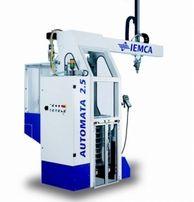


For companies striving to remain competitive in today’s aggressive market conditions, the traditional merits of price, quality and delivery are as valid for success as they have ever been. The need to relentlessly drive productivity up and costs down is a ‘given’ in the face of global supply chains and competition from low wage economies. In parallel, many UK manufacturers recognise the benefits of focusing their production on more complex, higher added-value jobs. This can often entail investment in new CNC machine tools. But, operating high capability machines without effective raw material or work handling equipment is simply false economy argues Giampaolo Morandi of bar feeder specialist IEMCA.
Ultimately, machine tools only pay their way when they are cutting metal. So, it’s no surprise that machine tool builders should devote most of their resources to maximising the proportion of cutting time within the overall machining cycle. The demand for ever-increasing productivity is reflected in ongoing developments to minimise tool indexing and rapid feed times, as well as to continually push up spindle speeds and metal removal rates. Yet some of the these hard won benefits will be wasted if component loading and unloading times are not minimised too, or the raw material feeder is incapable of allowing the machine to operate at its full capability.
As a specialist with many years’ experience in bar feeder and work handling equipment design, IEMCA works closely with machine tool manufacturers and their customers world-wide. The 450-strong company has two manufacturing plants in the Far East, as well as one in the USA and a further production facility at its headquarters in Italy.
According to the organisation’s sales and marketing director, Giampaolo Morandi, the requirements of the Asian and Western markets are very different. The emphasis in China and India is on simple, rugged and reliable barfeeders, whereas the focus in Europe and the USA is very much more on productivity, high turning speeds and minimal operator intervention. To illustrate his point he highlights IEMCA’s recently-introduced Elite 112 model, which is geared to the needs of the micromechanical market.
“Encompassing automotive, electronic, hydraulic, medical equipment and household fittings, along with specialist areas such as jewellery, timepieces, fashionware and optical equipment, this is a particularly buoyant sector at the moment,” he reports. “It is characterised by small, often intricate turned parts, which are typically produced on high speed CNC lathes or machining centres.
“To match the capabilities of these machines, the Elite 112 has been designed to accommodate spindle speeds of up to 25,000 rev/min and high headstock accelerations. Through the use of low inertia components, we are already able to ensure precise synchronisation with headstocks actuated by linear motors, which can operate at more than 2g. We are also in the process of developing new units capable of up to 5g in the near future.”
The new barfeeder is suitable for 0.8-12.7 mm diameter stock and employs closed, calibrated, round section channels and high performance rotating tips to ensure compatibility with even the fastest machine spindle speeds. It has a 28 bar capacity and achieves changes in just 26 seconds with 3.2 metre long stock. The Elite 112’s material magazine also features a stepping action that ensures extremely reliable operation with small diameter raw material. In addition, manufacturing productivity is enhanced by the unit’s purpose-designed snap-in channels, which enable change-over times to be reduced to as little as four minutes. Furthermore, a standard library of default settings – accessed through the machine’s control panel – means that no adjustments will normally be required during the equipment’s long and productive service life.
Primary Objective
According to Morandi, IEMCA’s primary objective is to continually enhance its product range in order to maximise the performance of CNC metalworking machines.
“Even relatively small improvements can be important in preventing the bar feeder from becoming a potential bottleneck,” he maintains. “Our collaboration with machine tool manufacturers covers all areas of design and manufacture, including minimising vibration that can be detrimental to overall cutting performance.
“Further developments focus on reducing operator input and maximising unattended running times through increased magazine capacities and the use of longer bars. Shorter stock necessitates more frequent reloading of the magazine. In addition, it generates more bar end remnants – a significant disadvantage in the light of current raw material prices.”
The philosophy that underpins IEMCA’s latest generation barfeeders has also been applied to the company’s newest workholding development, the Automata.
Marketed in Britain by the company’s UK agent, 1st Machine Tool Accessories, Automata is an integrated gantry system that boosts the productivity of a wide range of CNC manufacturing equipment, including lathes, grinders, rolling equipment and machining centres. Units offer a standard load/unload cycle time of just seven seconds and will automatically feed, unload and store bulk components weighing up to 5kg with a positional repeatability of+0.1 mm.
The Automata features easy-to-learn, intuitive controls and is supplied network-ready for fast and simple installation. Particular attention has also been paid to reducing the equipment’s standard retooling time to just seven minutes – making it equally suitable for use with short or extended production runs and an ideal solution for busy machine shops with frequent changeovers.
The use of high capacity palletisers or stackers in conjunction with the Automata allows lathes to run unsupervised and several machine tools to be controlled by a single operator, further increasing productivity. The equipment can also be equipped for ‘lights out’ operation, with SMS, webcam or email notification of job completion or the need for raw material replenishment.
“Latest generation loaders like the Automata deliver additional benefits, by enabling work flow to be streamlined for maximum throughput,” adds Morandi. “IEMCA’s goal is to keep reducing unproductive cycle time – either through joint development with our machine tool partners or through our own in-house innovations. Furthermore, by designing our feeders to be easily retrofitted to the widest variety of machine tools, we ensure that everyone can reap the benefits of our latest work handling developments.”
Through feedback from customers and discussions with machine tool manufacturers, Morandi expects automation to play an increasingly important role in reducing manufacturing costs and fulfilling both the quality and delivery expectations of sophisticated markets, such as the aerospace and medical equipment sectors.
“With their more complex components and scope for greater added value, I believe that these are the product areas that Western manufacturers will need to focus on in order to grow their businesses in future,” he adds.
“The application of latest bar feeder and work handling technology is an important factor in enabling metal cutting companies to realise the full potential of their existing or new machine tool assets. In my view, trying to compete without it will become increasingly difficult, especially against suppliers from low cost economies such as China or India.”
The full range of Iemca bar feeders are available from 1st MTA.